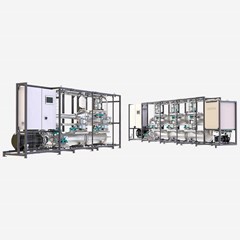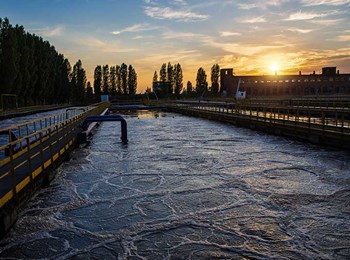Industrial wastewater is a great topic of the global environmental debate because it can have a long-term impact on the environment due to its excessive use of water and the harmful effects industrial wastewater has if discharged into the environment. Let us dive into more about what wastewater is and how to characterize industrial wastewater.
What Is Industrial Wastewater and What Are the Characteristics?
What Is Industrial Wastewater?
Industrial wastewater is an aqueous discard and by-product from most production industries like food and beverage, cloth and shoe production, electronic production, and heavy production sites such as mining, oil and gas, as well as chemical manufacturing. Water is used in the production process of commercial products across every industry or for cleaning activities taking place along with the process. Once the water has been used, it is considered wastewater.
Metal finishers are an example of an industry producing high amounts of wastewater. Metal finishers are producing significant amounts of sludge containing heavy metals, drastically harming the environment and the health of people and animals. That is why strict regulations for industrial wastewater treatment encompass the metal finish industry.
Industrial laundries produce large amounts of industrial wastewater as well. The wastewater generated by cleaning towels, uniforms, and doormats contains matters such as oil, grease, lint, sand, grit, heavy metals, and VOCs that must be treated before discharge.
These industries are just a fraction of many producing industrial wastewater, which is essential to treat before being discharged into the environment.
To comply with existing laws and discharge limits, any organic and inorganic pollutants in the water used in industrial production must be managed. Organic matter, metals, and other suspended solids in the industrial wastewater must be removed before the water can be safely discharged back to land and water environments or reused in plant operations.
Characteristics of Industrial Wastewater
Industrial wastewater has very variable quality and volume depending on the type of industry producing it. It may be highly biodegradable or not at all, and it may or may not contain compounds recalcitrant to treatment. The specific characteristics vary after industry production methods and plants.
The characteristic of industrial wastewater is split up into three categories: physical characteristics, chemical characteristics, and biological characteristics.
Physical characteristics:
- Turbidity
- Color
- Odor
- Total solids
- Temperature
Chemical characteristics due to chemical impurities:
- Chemical oxygen demand (COD)
- Total organic carbon (TOC)
- Nitrogen
- Phosphorus
- Chlorides
- Sulfates
- Alkalinity
- pH
- Heavy metal
- Trace elements
- Priority pollutants
Biological characteristics due to contaminants
- Biochemical oxygen demand (BOD)
- Oxygen required for nitrification
- Microbial population
These characteristics mentioned above are used to decide the solution method needed to comply with industrial wastewater's discharge limits and regulations.
Examples of Industrial Wastewater
As mentioned before, industrial wastewater varies radically in quality and substance depending on the industry and the production methods. Let us dive into a few common contaminations for industrial wastewater.
Heavy metal wastewater
The presence of heavy metals in industrial wastewater has been increasing with the growth of industry and human activities, such as the electroplating industry, batteries, pesticides, mining, metal rinse processes, etc. Moreover, heavy metals occur naturally in the environment in varying concentrations.
Heavy metals are non-biodegradable and can be carcinogenic; thus, the presence of these metals in drinking water in improper amounts can result in critical health issues for living organisms.
The most well-known heavy metals are:
- Lead (Pb),
- Zinc (Zn),
- Mercury (Hg),
- Nickel (Ni),
- Cadmium (Cd),
- Copper (Cu),
- Chromium (Cr)
- Arsenic (As).
Among others, these heavy metals are commonly available in industrial wastewater and must be removed before discharge.
Although pollution due to heavy metals is a global concern, levels of contamination vary from place to place.
Discharge of municipal, agricultural, and industrial wastewaters and sewage into rivers has been identified as a significant route of heavy metals into aquatic resources. The reason is that heavy metals easily adsorb to suspended particles in water, settling down in the riverbed, and are later released into the water column, where they become a potential secondary source of contamination, threatening ecosystems.
Nitrogen wastewater
Nitrogen ends up in the environment mainly through agricultural processes and as industrial wastewater from coloring production, synthetic gent production, and food production.
Nitrogen is a dietary requirement for all organisms because it is a constituent of all proteins and nucleic acids. Nitrogen is essential for plants and can be found in the air in large amounts.
The presence of nitrogen in the environment causes concern because the compounds of nitrogen and phosphorus affect the eutrophication in natural water – meaning supplying the water with too much sustenance. Furthermore, nitrate (nitrogen in a reactive form) can be a risk to human health. Which is the reason why industrial wastewater with high amounts of nitrogen is important to treat and clean.
Oily wastewater
Oily wastewater consists of fats, oils, and greases together with a broad spectrum of dissolved organic and/or inorganic substances in suspension. It is regarded as one of the most harmful industrial wastewaters, causing serious environmental and health threats to the ecosystems. The global increase in the discharge of oily wastewater coupled with stringent regulations for effluent discharge and incessant drive for reuse of treated industrial wastewater necessitate the need for the treatment of the wastewater.
Oil-contaminated wastewater is produced from various industries, including metal processing industries, restaurants, slaughterhouses, dairy industries, poultry processing industries, edible oil refineries, petrochemical industries, etc.
The oily industrial wastewater is characterized by:
- Biochemical oxygen demand (BOD)
- Total suspended solids (TSS)
- Chemical oxygen demand (COD)
- Ammonia
- Sulfides
- Total organic carbon
- Total petroleum hydrocarbon (TPH)
- Other toxic compounds
These characteristics are based on the operations and products from the producing industries.
As mentioned, industrial wastewater flows must be treated before being discharged into a biological treatment plant or into the environment. Generally, this can be done close to the site of production itself.
Even though industrial wastewater is defined as a by-product of production, it is a huge resource providing you with economical and financial benefits.

Have you seen our membrane filtration system?
Industrial membrane filtration system for future compliance and sustainable production. Click here to see our innovative solutions based on high-quality ceramic membranes.
Talk to an Expert
Please do not hesitate to contact us if you need help with a liquid filtration system.



